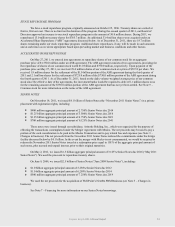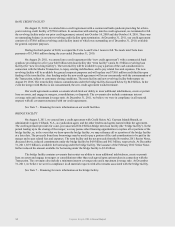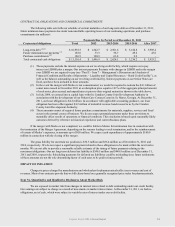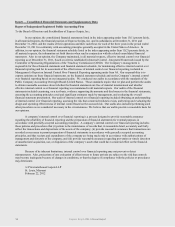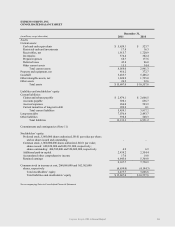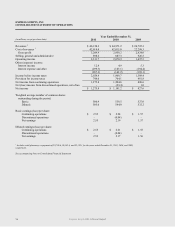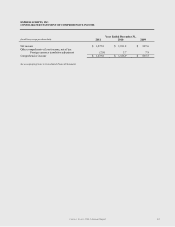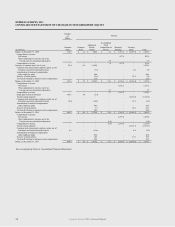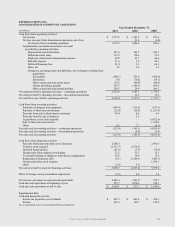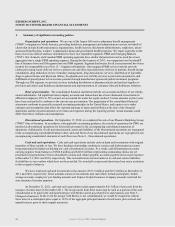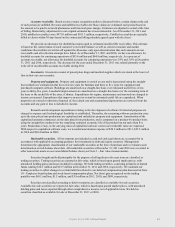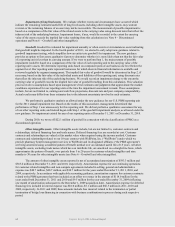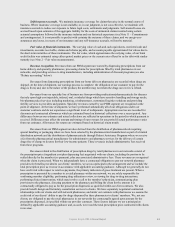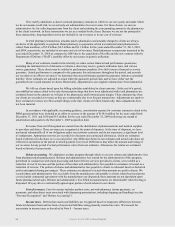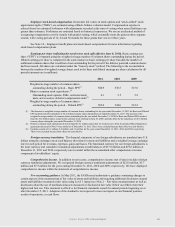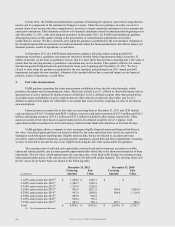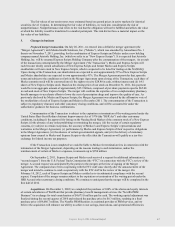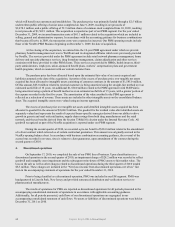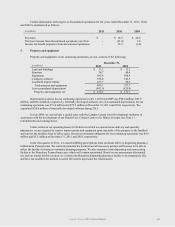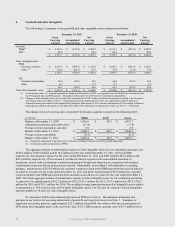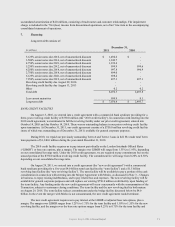Express Scripts 2011 Annual Report Download - page 63
Download and view the complete annual report
Please find page 63 of the 2011 Express Scripts annual report below. You can navigate through the pages in the report by either clicking on the pages listed below, or by using the keyword search tool below to find specific information within the annual report.
Express Scripts 2011 Annual Report 61
Accounts receivable. Based on our revenue recognition policies discussed below, certain claims at the end
of each period are unbilled. Revenue and unbilled receivables for those claims are estimated each period based on
the amount to be paid to network pharmacies and historical gross margin. Estimates are adjusted to actual at the time
of billing. Historically, adjustments to our original estimates have been immaterial. As of December 31, 2011 and
2010, unbilled receivables were $971.0 million and $911.3 million, respectively. Unbilled receivables are typically
billed to clients within 30 days based on the contractual billing schedule agreed upon with the client.
We provide an allowance for doubtful accounts equal to estimated uncollectible receivables. This estimate
is based on the current status of each customer’s receivable balance as well as current economic and market
conditions. Receivables are written off against the allowance only upon determination that such amounts are not
recoverable and all collection attempts have failed. As of December 31, 2011 and 2010, we have an allowance for
doubtful accounts for continuing operations of $55.6 million and $64.8 million, respectively. As a percent of
accounts receivable, our allowance for doubtful accounts for continuing operations was 2.9% and 3.8% at December
31, 2011 and 2010, respectively. The decrease for the year ended December 31, 2011 was related primarily to the
write off of uncollectible accounts receivable during 2011.
Inventories. Inventories consist of prescription drugs and medical supplies which are stated at the lower of
first-in first-out cost or market.
Property and equipment. Property and equipment is carried at cost and is depreciated using the straight-
line method over estimated useful lives of seven years for furniture and three to five years for equipment and
purchased computer software. Buildings are amortized on a straight-line basis over estimated useful lives of ten
years to thirty-five years. Leasehold improvements are amortized on a straight-line basis over the remaining term of
the lease or the useful life of the asset, if shorter. Expenditures for repairs, maintenance and renewals are charged to
income as incurred. Expenditures that improve an asset or extend its estimated useful life are capitalized. When
properties are retired or otherwise disposed of, the related cost and accumulated depreciation are removed from the
accounts and any gain or loss is included in income.
Research and development expenditures relating to the development of software for internal purposes are
charged to expense until technological feasibility is established. Thereafter, the remaining software production costs
up to the date placed into production are capitalized and included as property and equipment. Amortization of the
capitalized amounts commences on the date placed into production, and is computed on a product-by-product basis
using the straight-line method over the remaining estimated economic life of the product but not more than five
years. Reductions, if any, in the carrying value of capitalized software costs to net realizable value are expensed.
With respect to capitalized software costs, we recorded amortization expense of $26.2 million in 2011, $23.2 million
in 2010 and $20.4 million in 2009.
Marketable securities. All investments not included as cash and cash equivalents are accounted for in
accordance with applicable accounting guidance for investments in debt and equity securities. Management
determines the appropriate classification of our marketable securities at the time of purchase and re-evaluates such
determination at each balance sheet date. All marketable securities at December 31, 2011 and 2010 were recorded in
other noncurrent assets on our consolidated balance sheet (see Note 2 – Fair value measurements).
Securities bought and held principally for the purpose of selling them in the near term are classified as
trading securities. Trading securities are reported at fair value, which is based upon quoted market prices, with
unrealized holding gains and losses included in earnings. We held trading securities, consisting primarily of mutual
funds, totaling $14.1 million and $13.5 million at December 31, 2011 and 2010, respectively. We maintain our
trading securities to offset changes in certain liabilities related to our deferred compensation plan discussed in Note
10 – Employee benefit plans and stock-based compensation plans. Net (loss) gain recognized on the trading
portfolio was $(0.1) million, $1.5 million, and $3.8 million in 2011, 2010, and 2009, respectively.
Securities not classified as trading or held-to-maturity are classified as available-for-sale securities.
Available-for-sale securities are reported at fair value, which is based upon quoted market prices, with unrealized
holding gains and losses reported through other comprehensive income, net of applicable taxes. We held no
securities classified as available for sale at December 31, 2011 or 2010.


